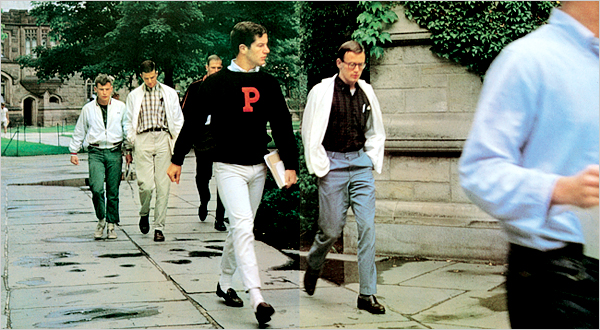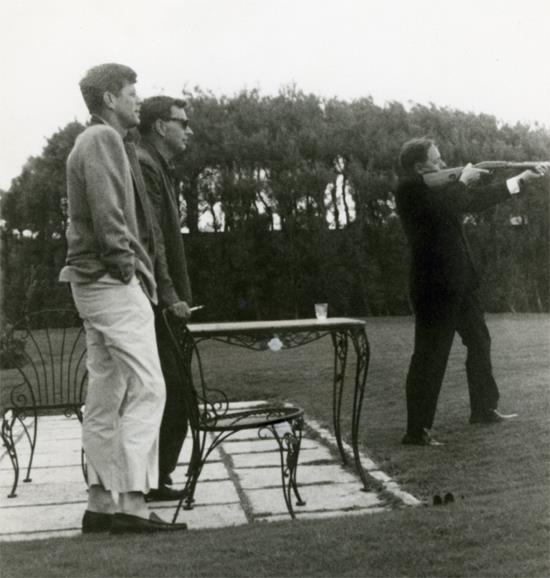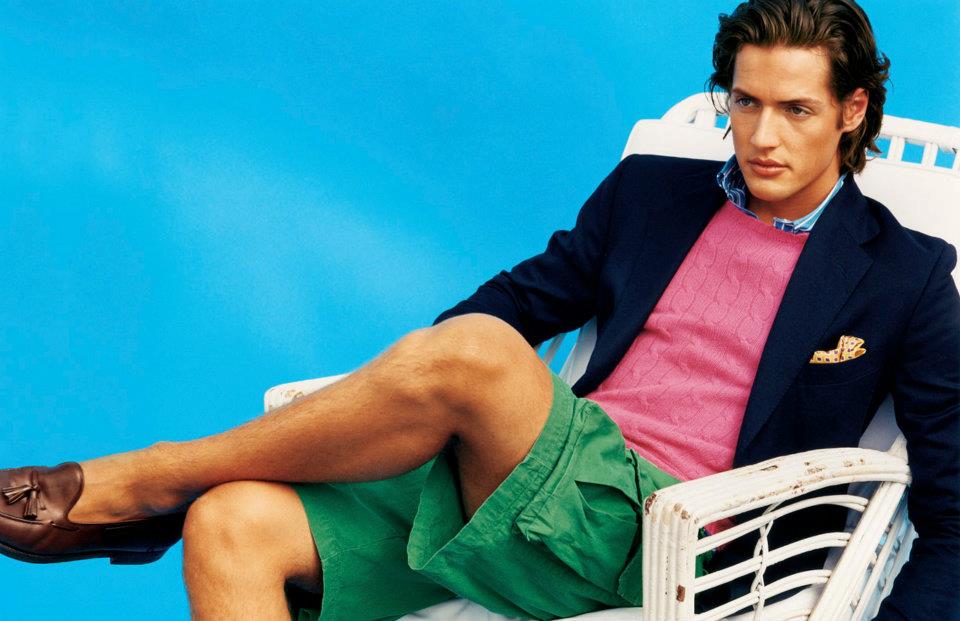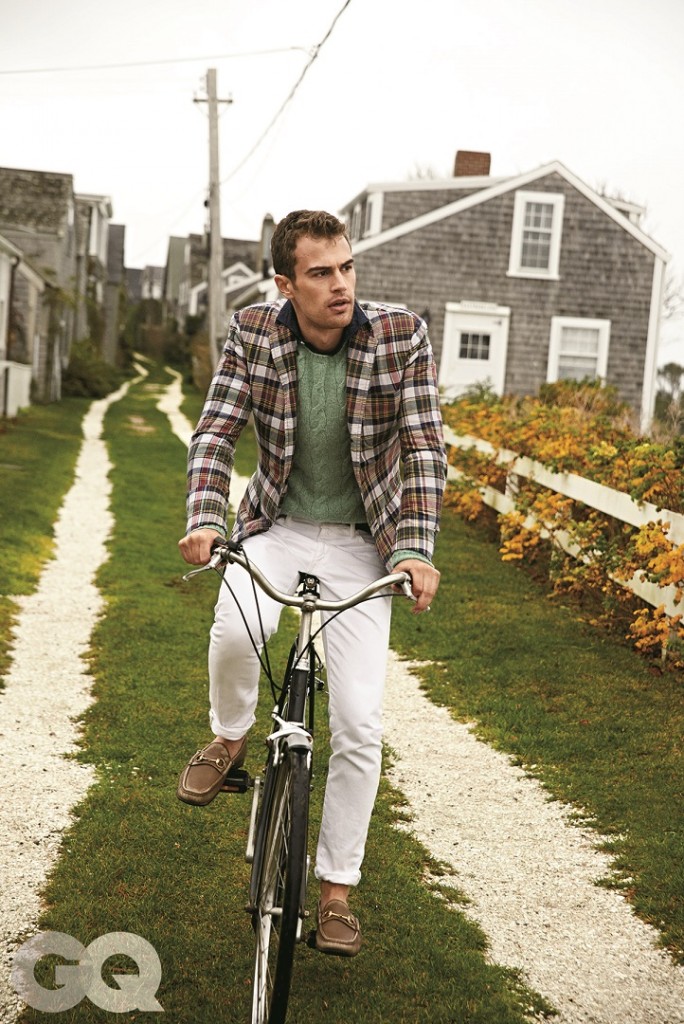As with much of life, the modern aesthetic we refer to as “preppy” bears only a thin resemblance to the historical roots upon which it rests. Often, the substance of a philosophy or belief is obscured over time as the surface decoration which was initially its outgrowth comes to define the entire idea. The same can be said of preppy fashion.
It’s not too dramatic to state that the preppy fashion meme of today is but a shallow construct masquerading as some sort of cultural touch point. The problem of course, is that preppy fashion has almost nothing to do with the culture it references, certainly not when it comes to actual, you know, culture. However, as we move into the Spring of 2014, it would appear that designers are finally beginning to see the limits of the hyper-preppy overkill that has saturated the menswear space for several years.
The eye-burning excess of colors, patterns, crests, layers, skulls-emblazoned-on-everything, big plaid with little plaid with repp stripes, and velvet slippers to the office, finally seems to have exhausted even the most ardent of trend spotters.
So now, at long last, we can move onto the next phase in the ongoing preppy style circle of life. As evidenced above in this relatively realistic GQ-styled take on preppy, a shift toward real life appears to be in motion. Actor Theo James’ outfit, shot appropriately on Nantucket island, is thoroughly believable and wearable. Thank goodness.
The Influence of Real Life
Actual preppy style (that is, the preppy style of dress) evolved from life in New England preparatory schools, which by and large expressed conservative protestant values and social stratification. Collectively, these influences created an environment which produced the uniform we know now as the preppy look.
Today, when someone is called (or calls themselves) “preppy,” it usually means that he dresses in a neo-traditional fashion, typically predicated on conveying a classically sporty lifestyle (crew, rugby, sailing, 1950s football, etc.). Often, but not always, it is simply costume; no sense of history or understanding of the preppy culture. That’s too bad, because actually, it’s a pretty interesting history.
 More so than other styles, preppy – East Coast, Ivy League, WASPy, call it what you will – has a real history behind it that clearly informs the fashion.
More so than other styles, preppy – East Coast, Ivy League, WASPy, call it what you will – has a real history behind it that clearly informs the fashion.
Perhaps that is why the style and implied lifestyle behind it, endures generation after generation. While you can look polished and successful in a nice suit and carrying an expensive bag, you can convey many more social, cultural and status cues looking as though you just hopped off your Hinkley yacht after spending a week at the Cape house.
While for the most part it started at New England prep schools and ivy walled colleges, the roots of preppy style can also be traced to a focus on social achievement, uniformity of style, propriety, proper decorum and class distinction. Conformity of dress at school resulted in the basic uniform of coat, tie, button down shirt, grey flannels or chinos and loafers or lace ups. Codes, traditions and sports also helped to nurture a bond and familiarity among budding preps and instilled in them a feeling of belonging.
A culture of thrift and purpose also pervaded the Ivy League world. Clothing was worn until it frayed, upon which it was patched and sewn. Garments were handed down and cherished, signs of age and wear denoted a certain authenticity and personality that only time conveys. Preppy style looks so good because it looks so worn and beat-up, lived in, and loved over time. This focus on These
This environment helped create a culture of exclusivity that had real influence. To say you prepped at Phillips Exeter (a feeder school for Harvard) or Hotchkiss (a feeder school for Yale) could win you access to the right social circle or get you into really great parties. And once in the working world, to say you were a Yale man could mean getting the right job, joining the right club or vacationing on Martha’s Vineyard.
From Exclusive to Popular Culture
As preps sought to instill that sense of tradition and lifestyle in their own children, they looked, of course, to their own preppy past. To the oak paneled lecture halls of Exeter, the squash courts of Deerfield and the rowdy but stylish nights at Choate Rosemary Hall. So, their offspring were trucked off to the old alma mater and the cycle began again.
 Without question, it was an exclusive, self-impressed, and privileged world that gave birth to preppy style and the culture that underpinned it. But, as with so many other attempts to create a homogenous bubble of exclusivity, the prep school aesthetic eventually moved beyond its original sphere of influence.
Without question, it was an exclusive, self-impressed, and privileged world that gave birth to preppy style and the culture that underpinned it. But, as with so many other attempts to create a homogenous bubble of exclusivity, the prep school aesthetic eventually moved beyond its original sphere of influence.
People want what they do not have or what seems more attractive than what they do. So, when the Preppy Handbook hit the shelves in 1980, its editor Lisa Birchach (herself a Brown grad) overnight became the arbiter of all things pink and green. People didn’t care that it was intended to be both a send-up of the “true” prep culture as well as a tongue and cheek education for those looking to emulate the life. They saw a way of living that was far more exciting, cultured, sporty and stylish than their own – and they wanted it.
For the first time, preppy culture had been distilled into a portable and easy to understand resource. It was, and remains, the de facto guidebook to being preppy. And, while she issued a follow-up, “True Prep” in 2010, the original remains unquestionably dominant in influence.
The privileged and windswept lifestyle that had taken generations of Blue Bloods to develop and refine was now a commodity to be bought and imitated. In that moment, the life of prep was effectively democratized. That is because once the Preppy Handbook came out, kids across the world latched onto the single most attractive and achievable aspect of the actual preppy’s life: its look – the rumpled and ironic blending of dress and casual clothes.
 In the intervening years, preppy style has been interpreted, parsed, watered down and ginned up to such a degree that for many it has been commoditized beyond recognition.
In the intervening years, preppy style has been interpreted, parsed, watered down and ginned up to such a degree that for many it has been commoditized beyond recognition.
In response, sites like Christian Chensvold’s Ivy Style launched as a sort of counterbalance, reminding people that this preppy fashion thing actually had a rich and important story behind it. Yes, anyone can dress preppy, but “being” preppy is actually something altogether different.
When we first broached this subject years ago, one OTC reader pointed out that what some only know of as iconic Ralph Lauren branding, the mixing of dress and functional clothing, did not actually start out as a fashion movement. His comment was in itself an expression of true preppy-ness:
“You don’t wear foul weather gear over your blazer because you’re a blue-blooded American demonstrating your accessibility without appearing tacky; you do it because you’re a wise-mouthed elitist who smugly tells your Latin professor, technically speaking, you haven’t broken any rules so there’s nothing he can do about it. And of course it’s sailing gear, because your father does own a yacht…”
The original audience for this rebellious “foul weather gear over the blazer” look was other preppies and their families. Yet, as this type of hybrid style came into its own, it seeped out into regular society. Eventually spreading to Madison Avenue, it was popularized by style influencers like the aforementioned Ralph Lauren. Over time, the prep boom of the 1980s waned due to its extreme and vibrant interpretation of the preppy culture – the same issue facing the trend today. At its apogee there was an almost cartoonish quality to the movement. Sound familiar?
Finding Preppy’s Roots
What we see moving into the American preppy space now is an interest in a more reality-based look; muted colors and less overt branding and styling, singular pops of color rather than a cacophony that overwhelms. Less “look at me, I’m preppy!” and more “oh, this old thing was my dad’s when he was in school.”
Hopefully, all this will translate into a more careworn, comfortable and vintage preppy personality; approachable and less precious than in the last few years. Many of the style’s adherents are now looking for a little substance behind the flash, the story behind the fashion, and a more accurate read on the overall Ivy League look.
How wonderful would it be for the renewed focus on menswear quality, detail, provenance, and longevity to extend to the history and culture behind that most American of fashions? Let’s make understanding the roots of American preppy as stylish as dressing in American preppy.

A cogent and accurate presentation. Bravo!
Thank you sir – coming from you that’s pretty high praise.
There is a fundamental focus on value when purchasing traditionally “preppy” items. “Shopping” for cheap trendy items is a foreign concept. Rather, items are procured or acquired slowly over time purely for their usefulness and longevity. The greatest value can be found in items that will receive plenty of use and still outlive you. I’ll gladly spend five times as much for something that will last ten times as long, provided I actually have a need for it in the first place.
Useless clutter is the enemy. Wasting money on poor quality is vulgar.
What many people don’t understand about the prep aesthetic is that the items are meant to be solutions. The sense of authenticity that people chase when purchasing trendy “preppy” items is really a pursuit of the sense of purpose that the items (and thus their owners) have. Items are worn in and worn out because they play an active role in enabling the life of their owner. The blazer earned those leather patches because the owner did.
In my view, there are always dreamers and those ready to make a name and/ or money off of them.
JFK has the most stylish outfit ever in the above picture! Love the high pants!